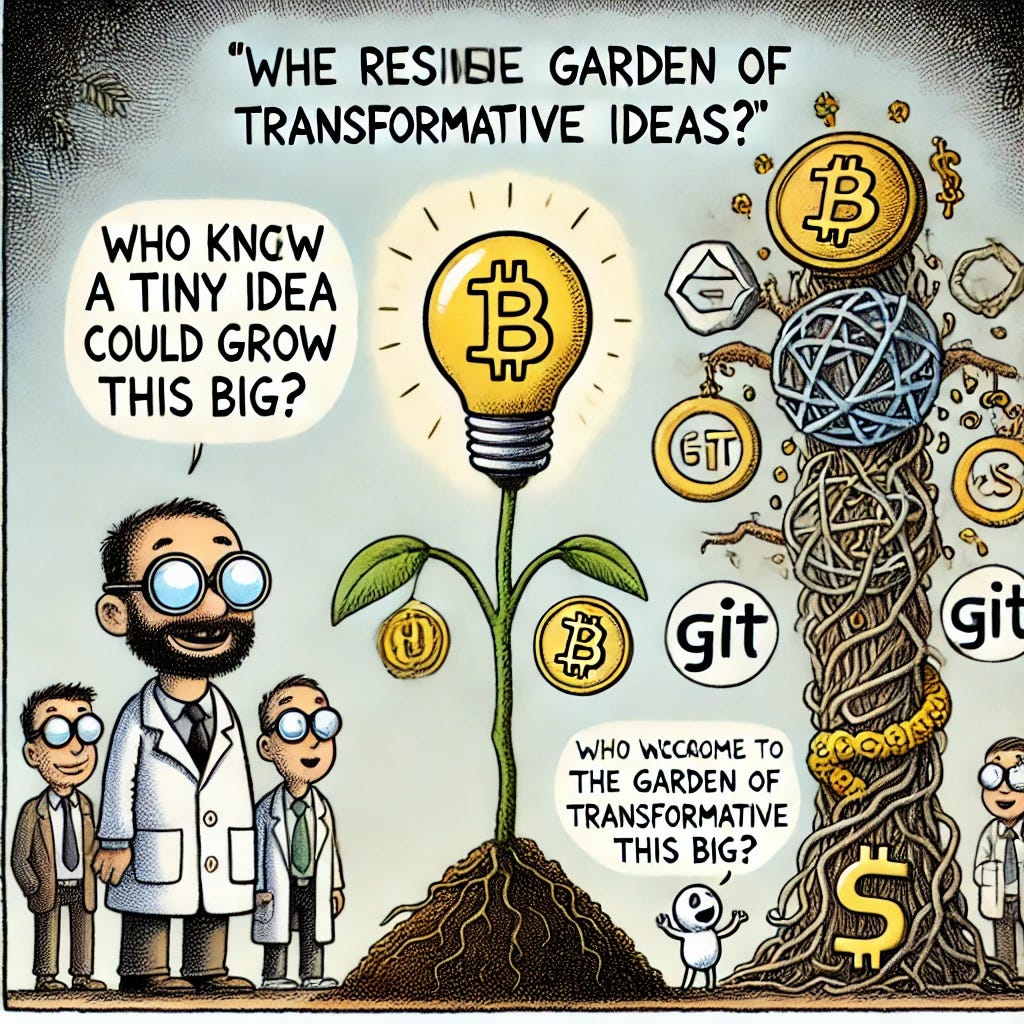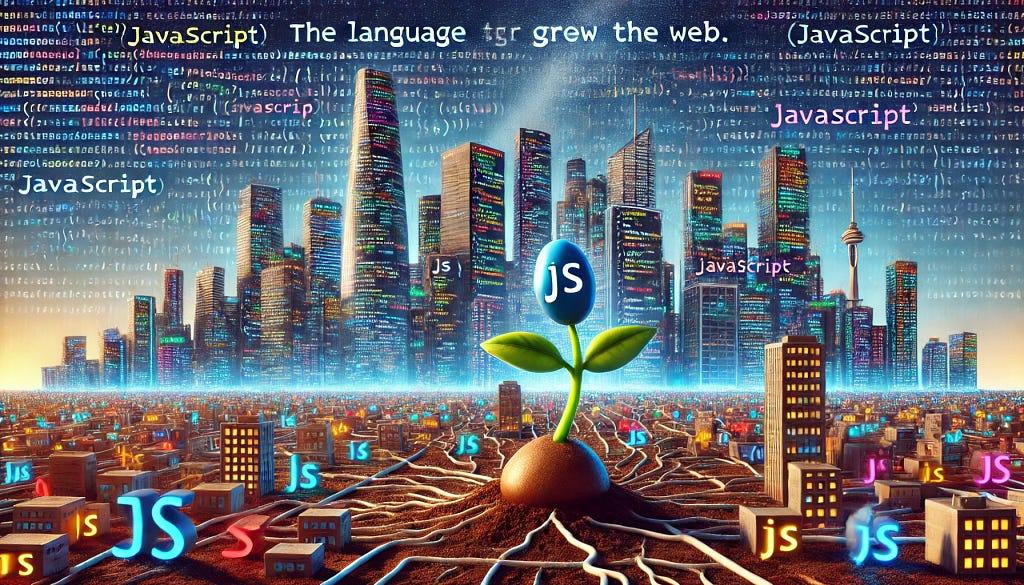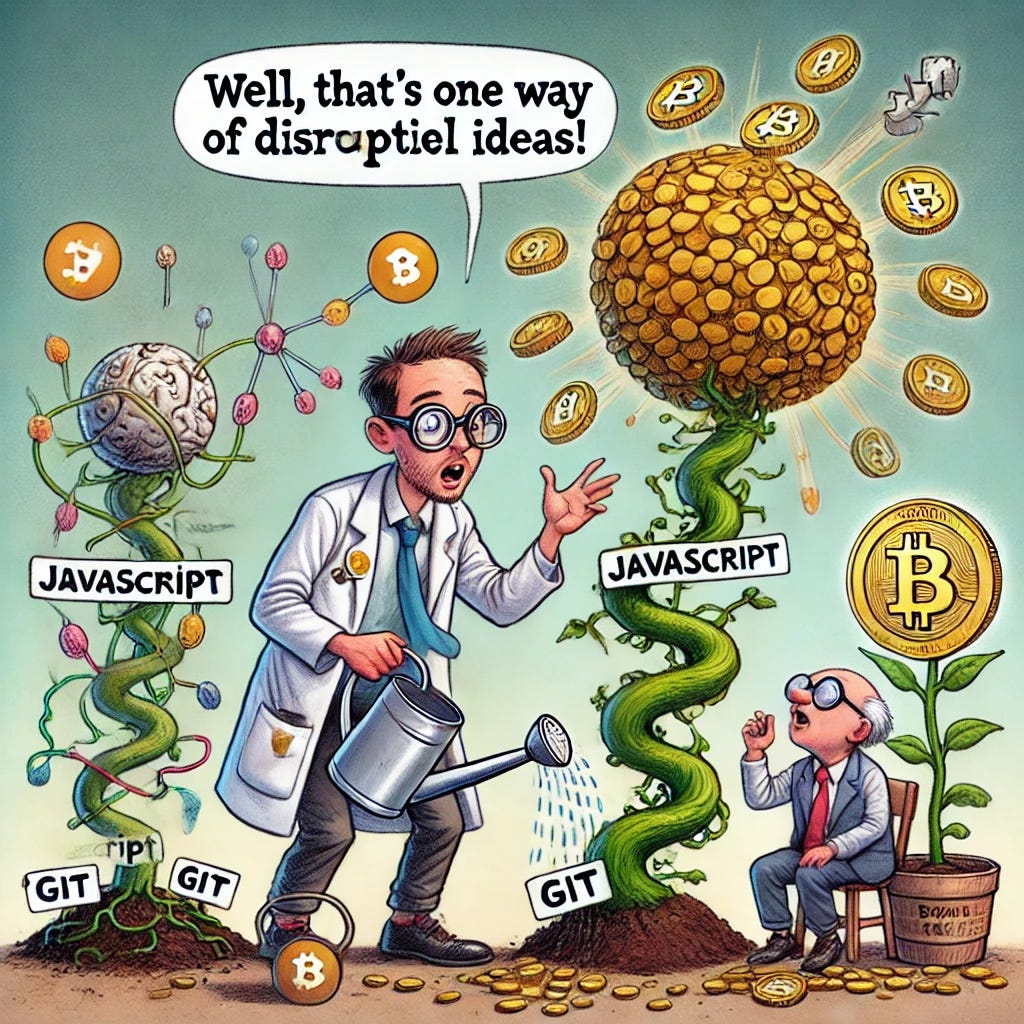From Humble Origins to Titans: How Ideas Transform Our World — From Javascript to Bitcoin
Ladies and gentlemen, let’s navigate the labyrinth of innovation together. Picture a solitary seed — modest yet potent — planted in the fertile ground of necessity. This seed grows into a towering force that redefines our digital landscape. Much like the intricate dreamscapes of Inception, where a single idea can alter reality in complex ways, technologies like JavaScript, Git, and Bitcoin have emerged from humble or intricate beginnings to become juggernauts of transformation. It’s intriguing how ideas, whether simple or sophisticated, evolve into catalysts that propel us into new epochs of technological advancement. Let’s delve into this phenomenon where notions ignite monumental change, reshaping industries and, indeed, our very world.
The Resilient Power of Ideas: How Simple Concepts Spark Global Transformation
In Inception, we learn that the most resilient parasite is an idea — simple, contagious, and capable of altering entire realities. Technology has shown us this, time and again. Sometimes, the most straightforward concepts — born out of necessity, ingenuity, or sheer visionary insight — plant themselves firmly in the world’s collective consciousness and grow into transformative forces.

JavaScript: Ten Days That Defined the Web
In 1995, Brendan Eich developed JavaScript in a mere ten days. Pause to let that sink in — a programming language that now powers almost every website was created faster than it takes to process a passport renewal. And yes, critics abounded. Developers lamented its quirks, its inconsistencies, its maddening idiosyncrasies. But here we are, decades later, with JavaScript as the indispensable bedrock of modern web development. Its triumph isn’t a nod to technical perfection; it’s a testament to accessibility, adaptability, and being at the right place at the right time.
Embracing Imperfection
So, why did JavaScript flourish despite its flaws? Timing and necessity. In the mid-90s, the web was evolving rapidly, and the need for interactive, dynamic sites was growing louder. JavaScript stepped up, filling a void in a way no other language could. Ironically, the very imperfections that drew criticism became the reason it thrived. These quirks inspired a community-driven evolution, spawning an ecosystem of frameworks and libraries that refined JavaScript’s capabilities over time. Think of it as an organic, slightly chaotic growth — an imperfect seed that, when nurtured by a passionate community, transformed into an essential tool.
JavaScript’s enduring success reminds us that innovation doesn’t always require a flawless foundation. Sometimes, it just needs a timely entry, the ability to meet immediate needs, and a community willing to roll up their sleeves. In this light, JavaScript isn’t just code; it’s a resilient idea that proves that what starts as a simple solution can, with the right ecosystem, shape an entire industry.

Git: The Maestro of Collaborative Chaos
Let’s step into 2005. Linus Torvalds, already revered as the creator of Linux, sought a new kind of version control system — a tool that could scale with the ever-growing complexity of collaborative software development. Enter Git not just another tool but a true paradigm shift in the way developers collaborate. With Git, Torvalds orchestrated a symphony of organized chaos, enabling developers to work together without fear of overwriting one another’s code. Git’s decentralized approach was bold, and it empowered thousands of developers to work on projects from anywhere on the planet, in harmony or even in mild discord, but always in sync.
The Invisible Backbone
Today, Git silently underpins over 99% of source code repositories worldwide. It’s the unassuming backbone of modern software development, seamlessly managing chaos like a conductor overseeing a silent orchestra. Its open-source foundation has invited contributions from around the globe, making it stronger and more adaptable with each iteration. Git’s rise wasn’t just a matter of chance; it solved real, pressing needs in a simple yet powerful way.
Git has become such an intrinsic part of development that we often forget it’s there — like the subconscious, quietly steering actions without direct acknowledgment. Its dominance, however, didn’t come out of nowhere. It earned its place by addressing the complexities of modern collaboration head-on, with elegance and precision.
The very concept of a decentralized version control system redefined what was possible for global collaboration, making Git an indispensable part of the software industry. In a world that grows more interconnected by the day, Git stands as a testament to the power of tools that embrace organized chaos to achieve remarkable harmony.

Bitcoin: The Dawn of Financial Autonomy
In 2008, Satoshi Nakamoto — a figure as mysterious as the currency he created — planted a revolutionary seed with Bitcoin. At its core, Bitcoin is elegantly simple: a decentralized, peer-to-peer digital currency existing beyond the grasp of any central authority. But beneath this simplicity lies a potent challenge to conventional finance, and the implications are profound. Bitcoin not only introduced blockchain technology — a transparent, immutable ledger — but it also fueled a trillion-dollar asset class that continues to spark debates and reshape perceptions of money.
From Obscurity to a Global Phenomenon
Bitcoin’s trajectory is nothing short of astonishing. What began as an obscure whitepaper, read by only the most hardcore cryptography enthusiasts, has transformed into a global financial instrument, recognized and debated from Wall Street to government corridors. Initially, Bitcoin was written off as a fad or, worse, a gimmick for tech eccentrics. Yet it weathered the storm of skepticism, criticism, and regulatory scrutiny to emerge as one of the most resilient and valuable assets in modern finance. Bitcoin is not just surviving; it’s thriving, reflecting the strength of an idea whose time has truly come.
Bitcoin’s ascent from obscurity to mainstream acceptance is the hallmark of an idea that resonates deeply, perhaps because it aligns with our intrinsic desire for autonomy and control. It’s a symbol of financial self-sovereignty in a digital age, allowing individuals to transact freely without intermediaries or borders. The concept resonates, especially as we grow ever more connected and crave alternatives to legacy systems that feel increasingly outdated. Bitcoin, in essence, is more than currency — it’s a movement.

Echoes of Inception: How Simple Ideas Redefined Reality
In Inception, an idea can be powerful enough to reshape someone’s entire reality. Similarly, technologies like JavaScript, Git, and Bitcoin began as solutions to specific problems but quickly evolved beyond their original intent, altering industries and economies alike. Their growth has been anything but linear; rather, it’s been exponential, driven by network effects that amplify their impact with each new user. The more people adopt these tools, the more valuable and indispensable they become — a testament to the power of viral adoption in the tech world.
The Irony of Simplicity
There’s a certain irony in the way simplicity can foster complexity. JavaScript’s unassuming syntax paved the way for some of the most intricate web applications we see today. Git’s straightforward command-line interface now underlies massive, collaborative projects involving thousands of developers worldwide. And Bitcoin, which started as a basic concept — a peer-to-peer currency outside traditional financial controls — has blossomed into a complex ecosystem of cryptocurrencies, smart contracts, and decentralized finance. Each of these technologies began with a simple premise, yet they have spawned entire industries.
The Snowball Effect
Think of these technologies as snowballs rolling downhill, gathering mass and momentum as they go. Early adopters — those willing to take a chance on something new — validated the potential of each technology, attracting more users and catalyzing a feedback loop that turned these small ideas into unstoppable forces. This network effect is one of the most formidable forces in technology, propelling fledgling ideas into global movements with astonishing speed.
Criticism and Ubiquity
Here’s the paradox: the most widely adopted technologies often draw the most criticism. Developers might complain about JavaScript, yet it’s everywhere. Traditional financiers have scoffed at Bitcoin, even as institutional money quietly pours in. This underscores a crucial truth in tech: utility trumps ideology. People may criticize, but if a tool is practical and effective, it sticks around.

Community as the Catalyst: The Unstoppable Force Behind Technological Titans
In the world of technology, community is the invisible engine powering progress. Each of these monumental technologies — JavaScript, Git, and Bitcoin — owes its success to the collective force of open-source collaboration. Open-source licensing was the unsung hero, enabling anyone to contribute, modify, and share. This open-door policy didn’t just accelerate innovation; it transformed these tools into evolving ecosystems, constantly refreshed by global talent. The result? Resilience, relevance, and rapid adaptation to whatever the future throws their way.
Visionaries Steering the Ship
Behind these groundbreaking technologies were individuals like Brendan Eich, Linus Torvalds, and Satoshi Nakamoto. These were more than just talented developers; they were visionaries. Each saw gaps in existing systems and had the audacity to address them, often under immense constraints. Eich created JavaScript in 10 days. Torvalds launched Git to improve collaboration. Nakamoto developed Bitcoin in response to the 2008 financial crisis. Their work wasn’t just innovation — it was audacious, a reminder that individuals with vision can shape the world.
Innovation Born from Constraints
Interestingly, limitations often drive creativity. Tight deadlines, limited resources, or opposition only fueled their resolve. JavaScript was created in a hurry, Git emerged from a practical need for better version control, and Bitcoin arose as an alternative to a faltering financial system. Rather than holding them back, these constraints shaped these technologies into resilient, adaptable forces.
Resilience and Viral Adoption
These tools didn’t just survive — they thrived. Alternatives have emerged — new programming languages, version control systems, and cryptocurrencies — but the originals remain steadfast. Why? Because they didn’t just fill gaps; they became pillars, built to last through rigorous testing, community-driven improvement, and genuine value.
Solving Real Problems
The secret to their success lies in solving real problems. JavaScript made the web interactive, Git empowered developers to collaborate on a global scale, and Bitcoin provided an alternative to centralized finance. By addressing these fundamental needs, they lowered barriers to adoption and became irreplaceable, even if not perfect.
The Ripple of Unintended Consequences
No one could have anticipated the seismic impact of these tools. What started as solutions to specific issues evolved into ecosystems around which entire industries were built. The creators couldn’t foresee this, but it’s a powerful reminder of the unpredictable nature of innovation.
Democratizing Innovation
The accessibility of these technologies democratized their respective fields. They empowered anyone — whether individuals or small teams — to create, disrupt, and contribute. They’ve fostered a culture of participation and shared progress, allowing technology to evolve beyond the intentions of any single creator.
A Legacy of Humble Beginnings
These technologies prove that you don’t need vast resources to change the world. A simple yet powerful idea, nurtured by a community and refined through time, can leave an indelible mark on society. They stand as enduring reminders that in technology, as in life, it’s often the humble beginnings that lead to the most profound legacies.

Seeds of Disruption: How Simple Ideas Shape Our Digital World
In the realm of technology, the simplest ideas can catalyze extraordinary transformations. JavaScript, Git, and Bitcoin — three creations born from necessity and a bit of audacious vision — have transcended their humble beginnings to become pillars of our digital landscape. Each started as a solution to a specific problem but quickly evolved into indispensable tools, each transforming its respective domain through community-driven adaptation, exponential growth, and a curious knack for turning criticism into ubiquity.
JavaScript transformed the web into a dynamic playground; Git orchestrated global collaboration with a decentralized flair; Bitcoin redefined finance with a vision of financial autonomy. They may have flaws, but their utility and resilience have propelled them beyond the usual lifecycle of innovation. In a digital age where network effects amplify adoption, these technologies didn’t just spread — they snowballed, creating entire ecosystems that are now integral to modern life. Their growth, while unexpected, illustrates a profound truth: sometimes, the world changes not through elaborate plans but through the perseverance of ideas that just work.

From Humble Origins to Titans: How Ideas Transform Our World — From javascript to Bitcoin was originally published in The Capital on Medium, where people are continuing the conversation by highlighting and responding to this story.
